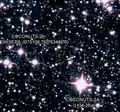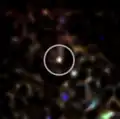COCONUTS-2b
COCONUTS-2 b, or WISEPA J075108.79-763449.6, is a gas giant exoplanet that orbits the M-type star L 34-26. With a mass of 6.3 Jupiters, it takes over one million years to complete one orbit around the star, and it is 7,506 AU away from it.[1]
 COCONUTS-2b with unWISE. The planet in the center of the image stands out due to its red color. The host star is not pictured here. | |
| Discovery | |
|---|---|
| Discovered by | Zhoujian Zhang Michael Liu Zach Claytor William Best Trent Dupuy Robert Siverd[1] |
| Discovery date | 2011 July 2021[2] |
| Direct imaging | |
| Designations | |
| WISEPA J075108.79-763449.6 | |
| Orbital characteristics | |
| 7,506.0 AU (1.12288×1012 km)[3] or ~0.1185 ly (~0.03633 pc) | |
| 1101369.9 years[3] | |
| Star | L 34-26 |
| Physical characteristics | |
Mean radius | 1.12±0.04 RJ[4] |
| Mass | 6.3+1.5 −1.9 MJ[5][3] |
| 4.11+0.11 −0.18 dex[5] | |
| Temperature | 434 ± 9 K[5] |
Spectral type | T9 |
The planet was discovered in 2011 and was initially identified as a T9 free-floating brown dwarf WISEPA J075108.79−763449.6.[6] During the COol Companions ON Ultrawide orbiTS (COCONUTS) survey, its association with L 34-26 was announced in 2021.[7] At a distance of 10.9 pc, COCONUTS-2b is the closest directly imaged exoplanet to Earth known to date.[8]
The researchers found that it is unlikely that COCONUTS-2b was formed inside the protoplanetary disk of the host star and it is more likely that the planet formed on its own via high entropy formation (aka hot-start process).[5][9]
Atmosphere
The planet has a spectral type of T9, based on a low signal-to-noise near-infrared spectrum with Magellan/FIRE.[6][5] This spectral type suggests high amounts of methane, water vapor and low amounts of carbon monoxide in the atmosphere of COCONUTS-2b.
COCONUTS-2b might have both clouds and a non-equilibrium process in its atmosphere.[5]
Due to its large orbital separation, COCONUTS-2b is a great laboratory to study the atmosphere and composition of young gas-giant exoplanets.[2] Astronomers estimate the planet’s temperature to be around 434 K (161 °C; 322 °F).[5]
Host star
L 34-26, also known as COCONUTS-2A and TYC 9381-1809-1, is a M3-type dwarf star located 35 light-years away, in the constellation of Chamaeleon. The star is about one-third the mass of the Sun, with an age between 150 and 800 million years old.[10]
Researchers using TESS found that L 34-26 showed stellar flares about every 0.48 days. It was the most active planet hosting star in their sample. The team studying the host star also found that L 34-26 is fast rotating with a rotation period of 2.83 days. The planet should not be influenced by the flares, because of the large orbital separation.[11]
Gallery
 The COCONUTS-2 system with unWISE
The COCONUTS-2 system with unWISE The planet COCONUTS-2b with Gemini-South
The planet COCONUTS-2b with Gemini-South Allwise image by the discoverers, showing planet COCONUTS-2b
Allwise image by the discoverers, showing planet COCONUTS-2b
References
- "Massive COCONUTS exoplanet discovery led by UH grad student | University of Hawaiʻi System News". University of Hawaiʻi News. University of Hawaiʻi at Mānoa. Archived from the original on 15 December 2021. Retrieved 21 December 2021.
- Kooser, Amanda. "Massive exoplanet 'Coconuts-2b' could help reveal the secrets of young gas giants". CNET. Archived from the original on 21 December 2021. Retrieved 21 December 2021.
- "COCONUTS-2 b". Exoplanet Exploration: Planets Beyond our Solar System. National Aeronautics and Space Administration. Archived from the original on 22 November 2021. Retrieved 21 December 2021.
- "COCONUTS-2". Open Exoplanet Catalogue. Archived from the original on 21 December 2021. Retrieved 21 December 2021.
- Zhang, Zhoujian; Liu, Michael C.; Claytor, Zachary R.; Best, William M. J.; Dupuy, Trent J.; Siverd, Robert J. (2021-08-01). "The Second Discovery from the COCONUTS Program: A Cold Wide-orbit Exoplanet around a Young Field M Dwarf at 10.9 pc". The Astrophysical Journal. 916 (2): L11. arXiv:2107.02805. Bibcode:2021ApJ...916L..11Z. doi:10.3847/2041-8213/ac1123. ISSN 0004-637X.
- Kirkpatrick, J. Davy; Cushing, Michael C.; Gelino, Christopher R.; Griffith, Roger L.; Skrutskie, Michael F.; Marsh, Kenneth A.; Wright, Edward L.; Mainzer, A.; Eisenhardt, Peter R.; McLean, Ian S.; Thompson, Maggie A.; Bauer, James M.; Benford, Dominic J.; Bridge, Carrie R.; Lake, Sean E. (2011-12-01). "The First Hundred Brown Dwarfs Discovered by the Wide-field Infrared Survey Explorer (WISE)". The Astrophysical Journal Supplement Series. 197 (2): 19. arXiv:1108.4677. Bibcode:2011ApJS..197...19K. doi:10.1088/0067-0049/197/2/19. ISSN 0067-0049. S2CID 16850733.
- "Exoplanet-catalog". Exoplanet Exploration: Planets Beyond our Solar System. Archived from the original on 2021-11-22. Retrieved 2021-11-22.
- Siegel, Ethan. "Astronomers Go Nuts For Closest Exoplanet Directly Imaged Ever: COCONUTS-2b". Forbes. Archived from the original on 2021-11-22. Retrieved 2021-11-22.
- Marley, Mark S.; Fortney, Jonathan J.; Hubickyj, Olenka; Bodenheimer, Peter; Lissauer, Jack J. (2007-01-01). "On the Luminosity of Young Jupiters". The Astrophysical Journal. 655 (1): 541–549. arXiv:astro-ph/0609739. Bibcode:2007ApJ...655..541M. doi:10.1086/509759. ISSN 0004-637X. S2CID 7793365.
- "Giant Exoplanet Orbits Its Host Star Once Every 1.1 Million Years | Astronomy | Sci-News.com". Breaking Science News | Sci-News.com. Archived from the original on 2021-11-22. Retrieved 2021-11-22.
- Stelzer, B.; Bogner, M.; Magaudda, E.; Raetz, St. (2022). "Flares and rotation of M dwarfs with habitable zones accessible to TESS planet detections". Astronomy and Astrophysics. 665: A30. arXiv:2207.03794. Bibcode:2022A&A...665A..30S. doi:10.1051/0004-6361/202142088. S2CID 249662585.


